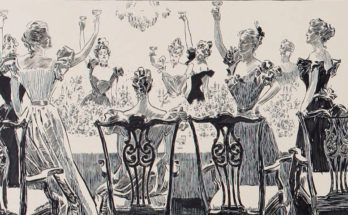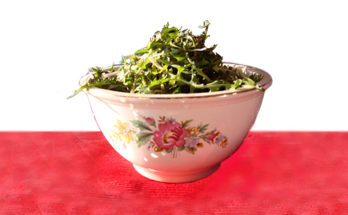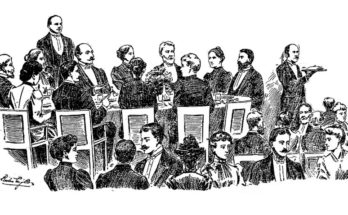Helen Johnson was at the eye of the storm in the changing times from homemakers being food producers to food consumers, which took place alongside the Industrial Revolution from the 1800s to the 1900s. She was a go-between for new-found companies of the industrial age and the women who purchased these convenience items never before seen by homemakers. She is most known for representing a company for hand-cranked food grinders to grind nuts and meats in the home. Yet she was also one of the earliest women who cooked on an electric cook stove when most people didn’t even have electricity in their homes.
Helen was born October 1866 in Watertown, New York, married, and by 1900 was divorced. We know nothing about that mysterious part of her life, but she graduated from Wells College near her parents’ home and the renowned Philadelphia Cooking School. While in Chicago in 1909, she took classes at the Art Institute of Chicago. Otherwise, Helen often lived with her parents, siblings, and servants at the family home in Watertown, where her father was a hotel proprietor. She went on cooking lecture tours and later moved to Manhattan.
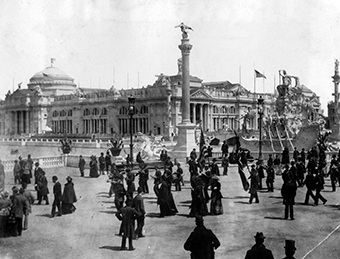
Helen Louise Johnson represented Ohio at the 1893 World’s Fair in Chicago. Her audience primarily consisted of house wives who had never witnessed the new invention of electric stoves. While most kitchens relied on wood, gas, or oil stoves, Helen showcased the marvels of electric cooking, and newspaper reporters scratching their heads with its novelty, reported that she ‘cooked with lightning.‘ She demonstrated the speedy broiling of a steak in a mere four minutes, and the art of bread baking. To bake bread, she heated the oven coils to 250 F. degrees before shutting them off, as there was no such thing as oven thermostats in the early stoves. The bread then cooked in the oven for 45 minutes.
Women’s clubs have been on the demise since the 1960s, so doesn’t seem plausible from this distance but from the 1890s to 1916 there were two kinds of women: club women and the women who wanted to be club women. Miss Helen Louise Johnson was a clubwoman. She was chairman of the General Federation of Women’s Clubs, home economics department, and later the editor of their magazine.
In the 1890s, Helen Louise Johnson was an editor at Table Talk magazine, a thoughtful women’s food magazine, later an editor of some of the top women’s magazines in the country. She was an active speaker in the 1910s, rallying for consumer and food company cooperation, home economics in public schools, unadulterated foods, truth in labeling on manufactured food products and minimizing women’s clothing design for its economy–so women would not be a financial slave to seasonal fashion changes. She was also an expert on home budgeting and an early advocate of electric kitchens–about 20 to 30 years before electricity’s regular use in the home.
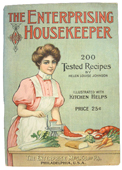
Because of the free booklets, Helen Louise Johnson was known as the author of The Enterprising Housekeeper [Reddit] which was Enterprise company’s hardware catalog and recipe booklet. To be enterprising was something everyone valued in the 1890s, and being the hay-days of the Industrial Revolution, the word enterprising was desirable. Early manufacturers who produced goods en mass and systematically advertised could become household names lasting over 100 years, providing for their families for generations. People becoming consumers of the products of the new manufacturers was a revolutionary change. In the late 1800s, householders switched from being producers of their food products, manufactured in the home since —forever— (with exceptions) to being consumers of canned, bottled, and manufactured foods of all kinds! This change also applied to non-food items.
Miss Helen Louise Johnson was an early supporter of this change to consumerism, with the acknowledged qualifier that homemakers had a voice via magazines and Women’s Clubs — insisting that manufacturers produce pure foods, truth in labeling, etc., which went into law with the voice of the woman’s clubs, the food manufacturers, and the US government of the day. Women were radical at that time — having voices, helping laws change, attaining women’s right to vote, the Married Women’s Act, etc. The world was changing quickly. Plenty of good came out of this Gilded Age, coined by Mark Twain, who meant it was glittering on the surface but was corrupt underneath.
The leading women of the early generation, such as Helen Louise Johnson, were optimistic they would ‘have a say’ over mass production and consumerism, and they united newly-formed consumers with companies to create this change through the written word, food demonstrations, and endorsements. The government encouraged the pivot to consumerism, funding domestic science programs in land-grant colleges and creating Cooperative Extension Services, including 4-H, throughout the nation beginning in the 1910s. Thousands of Extension Service Home Demonstrators and college graduates of domestic science programs educated America’s homemakers — particularly in the rural areas — to the benefits of ready-made products and in switching to new gas and electric utilities never before offered on this grand scale to the homemakers. Manufacturers needed a large number of consumers to make it work.
Manufacturers hired domestic scientists or home economists to bring acceptance of their manufactured household products to their biggest market, women. They valued women in public relations, demonstrating the use of the new products. The number of domestic scientists hired by companies to help market products is beyond counting, but here are some of the early influencers, with links to corresponding advertising booklets on Reddit —
Helen Louise Johnson for Enterprise Mnfg., Armour Meats, and electric cooking; Anne L. Pierce for Princess Royal canned goods, Mary Jean Hart for Igleheart Mills, Grace Viall Gray for Slaley’s Corn Oil, Marian Cole Fisher for Hubbard Milling Co., Anna J. Peterson for People’s Gas Co., Elizabeth Mann Clark for Cook & Phillips Grocers, Caroline B. King for Hershey, and others; and “big” names such as Maria Parloa, Marion Harland, Mrs. Rorer, Mary Lincoln, Fannie Farmer, Alice Bradley, Janet McKenzie Hill, Marion Harris Neil, Lily Haxworth Wallace, and other domestic scientists representing a plethora of early food and food equipment manufacturers.
Later, in the 1920s when fictitious names, perhaps beginning with Betty Crocker, were used by manufacturers, they needn’t depend on a living spokeswoman who lived and died, who had limited time and scope, inadequacies, or a colliding social rights agenda. Companies needn’t sell women on the idea of IF they were going to rely on a manufacturer, but from WHICH manufacturer they would purchase. The importance of women trained to represent companies was still prevalent but changing.
As the Gilded Age was long over, the first wave of manufacturers established, and housekeepers securely indoctrinated into the lifestyle of consumerism, Helen Louise Johnson’s journey seemed complete. She died on March 5, 1926, in Manhattan. Ten years later, most of the households in the United States would have electricity in the home for lights and electric kitchens.
Sketch of Helen Louise Johnson’s Career
Booklets:
- 1894 Chafing-dish Delicacies
- 1894 Recipes For the Sutterley Chafing Dish
- 1901 Culinary Wrinkles Recipes and Directions for the use of Armour’s Extract of Beef [free google books]
- 1898, 1900, 1902, 1906 The Enterprising Housekeeper [Reddit]
- War-time recipes that save food waste, co-authored: wrote the jelly, fruit butter and beverage recipes section
> Home Economist, lecturer, demonstrator, editor, author of magazine articles
> Editor, Magazines: Table Talk, Harper’s Bazar, Good Housekeeping, GFWC magazine
> General Federation of Women’s Clubs (GFWC) Chairman, Home Economics department
> 1893 World’s Fair demonstrator of electricity in the kitchen; 1894 Pure Foods Expo in charge of the cooking school
Note: top mini-video is AI animation of Helen Louise Johnson’s 1912 photo.
